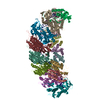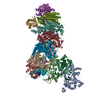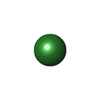+ Open data
Open data
- Basic information
Basic information
| Entry | Database: PDB / ID: 7tra | |||||||||||||||||||||||||||||||||||||||||||||
|---|---|---|---|---|---|---|---|---|---|---|---|---|---|---|---|---|---|---|---|---|---|---|---|---|---|---|---|---|---|---|---|---|---|---|---|---|---|---|---|---|---|---|---|---|---|---|
| Title | Cascade complex from type I-A CRISPR-Cas system | |||||||||||||||||||||||||||||||||||||||||||||
 Components Components |
| |||||||||||||||||||||||||||||||||||||||||||||
 Keywords Keywords | RNA BINDING PROTEIN / CRISPR / cascade / Cas3 / type I-A / genome editing / DNA targeting | |||||||||||||||||||||||||||||||||||||||||||||
| Function / homology |  Function and homology information Function and homology informationcatalytic activity, acting on DNA / exonuclease activity / endonuclease activity / defense response to virus / nucleic acid binding / Hydrolases; Acting on ester bonds / hydrolase activity / RNA helicase activity / ATP binding / metal ion binding / cytosol Similarity search - Function | |||||||||||||||||||||||||||||||||||||||||||||
| Biological species |   Pyrococcus furiosus DSM 3638 (archaea) Pyrococcus furiosus DSM 3638 (archaea) | |||||||||||||||||||||||||||||||||||||||||||||
| Method | ELECTRON MICROSCOPY / single particle reconstruction / cryo EM / Resolution: 3.3 Å | |||||||||||||||||||||||||||||||||||||||||||||
 Authors Authors | Hu, C. / Ni, D. / Nam, K.H. / Majumdar, S. / McLean, J. / Stahlberg, H. / Terns, M. / Ke, A. | |||||||||||||||||||||||||||||||||||||||||||||
| Funding support |  United States, United States,  Switzerland, 3items Switzerland, 3items
| |||||||||||||||||||||||||||||||||||||||||||||
 Citation Citation |  Journal: Mol Cell / Year: 2022 Journal: Mol Cell / Year: 2022Title: Allosteric control of type I-A CRISPR-Cas3 complexes and establishment as effective nucleic acid detection and human genome editing tools. Authors: Chunyi Hu / Dongchun Ni / Ki Hyun Nam / Sonali Majumdar / Justin McLean / Henning Stahlberg / Michael P Terns / Ailong Ke /    Abstract: Type I CRISPR-Cas systems typically rely on a two-step process to degrade DNA. First, an RNA-guided complex named Cascade identifies the complementary DNA target. The helicase-nuclease fusion enzyme ...Type I CRISPR-Cas systems typically rely on a two-step process to degrade DNA. First, an RNA-guided complex named Cascade identifies the complementary DNA target. The helicase-nuclease fusion enzyme Cas3 is then recruited in trans for processive DNA degradation. Contrary to this model, here, we show that type I-A Cascade and Cas3 function as an integral effector complex. We provide four cryoelectron microscopy (cryo-EM) snapshots of the Pyrococcus furiosus (Pfu) type I-A effector complex in different stages of DNA recognition and degradation. The HD nuclease of Cas3 is autoinhibited inside the effector complex. It is only allosterically activated upon full R-loop formation, when the entire targeted region has been validated by the RNA guide. The mechanistic insights inspired us to convert Pfu Cascade-Cas3 into a high-sensitivity, low-background, and temperature-activated nucleic acid detection tool. Moreover, Pfu CRISPR-Cas3 shows robust bi-directional deletion-editing activity in human cells, which could find usage in allele-specific inactivation of disease-causing mutations. | |||||||||||||||||||||||||||||||||||||||||||||
| History |
|
- Structure visualization
Structure visualization
| Structure viewer | Molecule:  Molmil Molmil Jmol/JSmol Jmol/JSmol |
|---|
- Downloads & links
Downloads & links
- Download
Download
| PDBx/mmCIF format |  7tra.cif.gz 7tra.cif.gz | 765.8 KB | Display |  PDBx/mmCIF format PDBx/mmCIF format |
|---|---|---|---|---|
| PDB format |  pdb7tra.ent.gz pdb7tra.ent.gz | Display |  PDB format PDB format | |
| PDBx/mmJSON format |  7tra.json.gz 7tra.json.gz | Tree view |  PDBx/mmJSON format PDBx/mmJSON format | |
| Others |  Other downloads Other downloads |
-Validation report
| Summary document |  7tra_validation.pdf.gz 7tra_validation.pdf.gz | 1022.3 KB | Display |  wwPDB validaton report wwPDB validaton report |
|---|---|---|---|---|
| Full document |  7tra_full_validation.pdf.gz 7tra_full_validation.pdf.gz | 1.1 MB | Display | |
| Data in XML |  7tra_validation.xml.gz 7tra_validation.xml.gz | 114.8 KB | Display | |
| Data in CIF |  7tra_validation.cif.gz 7tra_validation.cif.gz | 178.6 KB | Display | |
| Arichive directory |  https://data.pdbj.org/pub/pdb/validation_reports/tr/7tra https://data.pdbj.org/pub/pdb/validation_reports/tr/7tra ftp://data.pdbj.org/pub/pdb/validation_reports/tr/7tra ftp://data.pdbj.org/pub/pdb/validation_reports/tr/7tra | HTTPS FTP |
-Related structure data
| Related structure data |  26084MC  7tr6C  7tr8C  7tr9C M: map data used to model this data C: citing same article ( |
|---|---|
| Similar structure data | Similarity search - Function & homology  F&H Search F&H Search |
- Links
Links
- Assembly
Assembly
| Deposited unit | 
|
|---|---|
| 1 |
|
- Components
Components
-CRISPR-associated ... , 2 types, 2 molecules AQ
| #1: Protein | Mass: 61412.555 Da / Num. of mol.: 1 Source method: isolated from a genetically manipulated source Source: (gene. exp.)   Pyrococcus furiosus DSM 3638 (archaea) / Strain: ATCC 43587 / DSM 3638 / JCM 8422 / Vc1 / Gene: cas3, PFDSM3638_03195 / Production host: Pyrococcus furiosus DSM 3638 (archaea) / Strain: ATCC 43587 / DSM 3638 / JCM 8422 / Vc1 / Gene: cas3, PFDSM3638_03195 / Production host:  |
|---|---|
| #6: Protein | Mass: 24778.203 Da / Num. of mol.: 1 Source method: isolated from a genetically manipulated source Source: (gene. exp.)   Pyrococcus furiosus DSM 3638 (archaea) / Strain: ATCC 43587 / DSM 3638 / JCM 8422 / Vc1 / Gene: cas3, cas3'', PF0639 / Production host: Pyrococcus furiosus DSM 3638 (archaea) / Strain: ATCC 43587 / DSM 3638 / JCM 8422 / Vc1 / Gene: cas3, cas3'', PF0639 / Production host:  References: UniProt: Q8U336, Hydrolases; Acting on ester bonds |
-Protein , 4 types, 14 molecules BCDEFGHIJKLMNO
| #2: Protein | Mass: 38800.719 Da / Num. of mol.: 1 Source method: isolated from a genetically manipulated source Source: (gene. exp.)   Pyrococcus furiosus DSM 3638 (archaea) / Strain: ATCC 43587 / DSM 3638 / JCM 8422 / Vc1 / Gene: PF0637 / Production host: Pyrococcus furiosus DSM 3638 (archaea) / Strain: ATCC 43587 / DSM 3638 / JCM 8422 / Vc1 / Gene: PF0637 / Production host:  | ||||
|---|---|---|---|---|---|
| #3: Protein | Mass: 12208.933 Da / Num. of mol.: 5 Source method: isolated from a genetically manipulated source Source: (gene. exp.)   Pyrococcus furiosus DSM 3638 (archaea) / Strain: ATCC 43587 / DSM 3638 / JCM 8422 / Vc1 / Gene: PF0643 / Production host: Pyrococcus furiosus DSM 3638 (archaea) / Strain: ATCC 43587 / DSM 3638 / JCM 8422 / Vc1 / Gene: PF0643 / Production host:  #4: Protein | Mass: 36989.148 Da / Num. of mol.: 7 Source method: isolated from a genetically manipulated source Source: (gene. exp.)   Pyrococcus furiosus DSM 3638 (archaea) / Strain: ATCC 43587 / DSM 3638 / JCM 8422 / Vc1 / Gene: PF0642 / Production host: Pyrococcus furiosus DSM 3638 (archaea) / Strain: ATCC 43587 / DSM 3638 / JCM 8422 / Vc1 / Gene: PF0642 / Production host:  #5: Protein | | Mass: 29147.219 Da / Num. of mol.: 1 Source method: isolated from a genetically manipulated source Source: (gene. exp.)   Pyrococcus furiosus DSM 3638 (archaea) / Strain: ATCC 43587 / DSM 3638 / JCM 8422 / Vc1 / Gene: cas5a, PFDSM3638_03200 / Production host: Pyrococcus furiosus DSM 3638 (archaea) / Strain: ATCC 43587 / DSM 3638 / JCM 8422 / Vc1 / Gene: cas5a, PFDSM3638_03200 / Production host:  |
-DNA chain , 2 types, 2 molecules ST
| #8: DNA chain | Mass: 13692.797 Da / Num. of mol.: 1 / Source method: obtained synthetically / Source: (synth.)  |
|---|---|
| #9: DNA chain | Mass: 7727.109 Da / Num. of mol.: 1 / Source method: obtained synthetically / Source: (synth.)  |
-RNA chain / Non-polymers , 2 types, 3 molecules R

| #10: Chemical | | #7: RNA chain | | Mass: 14028.332 Da / Num. of mol.: 1 / Source method: isolated from a natural source / Source: (natural)  |
|---|
-Details
| Has ligand of interest | Y |
|---|---|
| Has protein modification | Y |
-Experimental details
-Experiment
| Experiment | Method: ELECTRON MICROSCOPY |
|---|---|
| EM experiment | Aggregation state: PARTICLE / 3D reconstruction method: single particle reconstruction |
- Sample preparation
Sample preparation
| Component | Name: full R-loop state of Cas3-Cascade complex from Pyrococcus furiosus type I-A CRISPR/Cas system Type: COMPLEX / Details: full R-loop state / Entity ID: #1-#9 / Source: MULTIPLE SOURCES | ||||||||||||
|---|---|---|---|---|---|---|---|---|---|---|---|---|---|
| Molecular weight | Value: 0.45 MDa / Experimental value: YES | ||||||||||||
| Source (natural) |
| ||||||||||||
| Source (recombinant) | Organism:  | ||||||||||||
| Buffer solution | pH: 7.5 | ||||||||||||
| Buffer component | Conc.: 150 mM / Name: sodium chloride / Formula: NaCl | ||||||||||||
| Specimen | Conc.: 1 mg/ml / Embedding applied: NO / Shadowing applied: NO / Staining applied: NO / Vitrification applied: YES | ||||||||||||
| Specimen support | Grid material: COPPER / Grid mesh size: 200 divisions/in. / Grid type: Quantifoil R1.2/1.3 | ||||||||||||
| Vitrification | Instrument: FEI VITROBOT MARK IV / Cryogen name: ETHANE / Humidity: 100 % / Chamber temperature: 298 K / Details: 6 seconds |
- Electron microscopy imaging
Electron microscopy imaging
| Microscopy | Model: TFS TALOS |
|---|---|
| Electron gun | Electron source:  FIELD EMISSION GUN / Accelerating voltage: 200 kV / Illumination mode: FLOOD BEAM FIELD EMISSION GUN / Accelerating voltage: 200 kV / Illumination mode: FLOOD BEAM |
| Electron lens | Mode: DIFFRACTION / Nominal defocus max: 2500 nm / Nominal defocus min: 1500 nm / Calibrated defocus min: 1000 nm / Cs: 2.7 mm / C2 aperture diameter: 100 µm |
| Image recording | Average exposure time: 2.5 sec. / Electron dose: 50 e/Å2 / Film or detector model: GATAN K3 BIOQUANTUM (6k x 4k) / Num. of real images: 1209 |
| EM imaging optics | Phase plate: VOLTA PHASE PLATE |
- Processing
Processing
| Software | Name: PHENIX / Version: 1.19.2_4158: / Classification: refinement | ||||||||||||||||||||||||||||
|---|---|---|---|---|---|---|---|---|---|---|---|---|---|---|---|---|---|---|---|---|---|---|---|---|---|---|---|---|---|
| EM software |
| ||||||||||||||||||||||||||||
| Image processing | Details: full R-loop state of type I-A CRISPR/cas complex | ||||||||||||||||||||||||||||
| CTF correction | Type: PHASE FLIPPING AND AMPLITUDE CORRECTION | ||||||||||||||||||||||||||||
| 3D reconstruction | Resolution: 3.3 Å / Resolution method: FSC 0.143 CUT-OFF / Num. of particles: 44773 / Symmetry type: POINT | ||||||||||||||||||||||||||||
| Atomic model building | Protocol: OTHER | ||||||||||||||||||||||||||||
| Refine LS restraints |
|
 Movie
Movie Controller
Controller







 PDBj
PDBj
































































